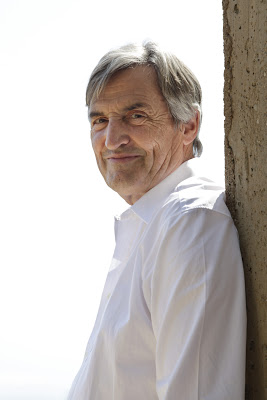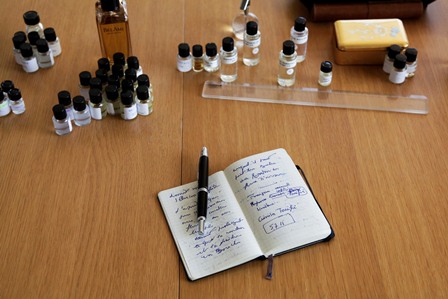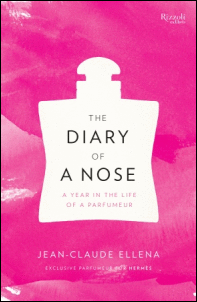"As I see it, perfume whispers to our noses, speaks to us intimately, makes connections with our thoughts.
In order to express this, I bend the market rules by breaking away from women's versus men's dogma.
I do not like the terms 'unisex' or 'mixed'; usage does not define a genre.
Which is why I make perfume for sharing, novel-perfumes, novella perfumes and poem perfumes."
– Jean-Claude Ellena, Cabris, Wednesday 30 June 2010
The Diary of A Nose -A Year in the Life of a Parfumeur is the journal of a year (October 19, 2009- October 13, 2010) in the life of one of Modern Perfumery's Maestros -Jean-Claude Ellena. As I sit in front of my keyboard to "share" with CaFleureBon readers my thoughts on the second book written by Jean-Claude Ellena, the self proclaimed "writer of smells", I realize that the diary was written six months after my interview with M. Ellena and answers so many questions that I would have asked and ones that would not have occurred to me.
When corresponding with me, he called himself a "quiet, smiling man, who prefers to listen than to speak"; that sense of humility is present on every page. Often he refers to himself as a craftsman and struggles with the idea of being an artist; when asked by a journalist if he knew he had a gift, M.Ellena says no. He experiences perfumer's block (especially when working on constructing a mint accord) and is often tired, glum and filled with anguish, but trips to fruit markets, a friend's home, a beloved book or listening to jazz and classical music renew him. He may pen his thoughts in a moleskin diary but he is no stranger to technology as he relays his experiences with the iPhone app Shazaam. M. Ellena is more comfortable meeting orange farmers in Southern Italy than answering questions at a seminar in Paris. He is perplexed by the success of Terre d'Hermes and baffled by the unpopularity of Un Jardin Apres Le Mousson, which he considered one of the "most beautiful floral compositions I have ever written".
Like his fragrances, his 117 page journal is a study in "simpl-exity"; rather than focusing on daily activities each entry reveals his thoughts on subjects that matter to him. The opening quote, is from the entry Resistance. Each date and place entry is subtitled… Craftsman & Artists, Sixth Sense, Standardization,Quality, Beauty, Mint Again are examples. Past and future compositions are fragrant threads that run throughout the book, whether he is writing about creating a complex fragrance with only ten components, as in the case of L'Artisan Parfumeur Bois de Farine, ruminating about the abstract nature of fragrance over the concrete liquid in the bottle or as in the entry Princess and the Pea, realizing his dream to create the ultimate feminine fragrance with pear as its central accord (which he names "Nebulous", a word he learned from Mobius the designer of the Voyage D'Hermes flacon).
His views are often controversial, perhaps not to indie and niche Houses, but certainly to the Industry. When he attends a trend presentation by a well known flavor and fragrance company, he was "shocked and disgusted…too many perfumes smell alike and are variations of best sellers". In his entry, The Pygmalian Myth, M. Ellena does not have much respect for Marketing Directors who are making the decisions on what is made and by whom (although I am quite sure it was a marketing director, not M. Ellena who chose the hot pink jacketof this book). He believes that too many Project managers are playing Pygmalion with young noses who they identify as gifted noses, while paradoxically relying on market trials, "they exhaust the young creators by asking for more and more daily samples, not respecting the time needed for evaluation and reflection." M. Ellena also believes that multi-perfumer collaborations, unless freely chosen, do not succeed.
One of the discoveries from my 2009 interview was that Paul Cezanne was M. Ellena's favorite artist. In the entry from Suggestions 22 September 2010, Cabris; M. Ellena remembers a conversation he had with the painter Emile Bernard on how Cezanne approached his watercolors. Bernard explains Cezanne starts by painting shadows and layers color upon color but if you look closely all the areas of color do not completely cover each other but are juxtaposed.This creates a remarkable harmony. "I proceed in a similar fashion when modeling a perfume by freeing myself from the mindset of proportions…It is the raw materials that shape a perfume; when they are juxtaposed they set up resonances. When I try to establish harmony, the proportions establish themselves".
The casual reader of A Diary of a Nose will be excited by the generous glimpses into Jean-Claude Ellena's life… from his IKEA work desk in Cabris (Grasse) to his fascination with China and his travels to Japan while composing Iris Ukiyoé. There are insights into his perfumes, the ones he has created and those he has yet to finish, his childhood, his teacher Edmond Roudnitska (who once dreamed of being an Opera Singer), his frustrations with IFRA, and his admiration for Chanel' s "rewriting" of No. 5 with Eau Premiere.
For the perfumer or those who aren't aromachemically challenged there are accord formulas; how to create "olfactory illusions" such as the aromas of green, yellow and red apples, hyancinth, mango, cherry and candyfloss.
And yes, he reads perfume blogs.
.-Michelyn Camen, Editor in Chief
Disclosure: an Advance Copy of A Diary of A Nose was given to me by Rizzoli Ex Libris the U.S. publisher. All photos used with the permission of the publisher
Thanks to Rizzoli New York we have an advance copy of The Diary of A Nose A Year in the Life of a Perfumer to giveaway to one reader. To be eligible leave a comment on anything that resonated for you in this book review by January 9, 2013. The winner will be announced by the January 15, 2013 so that a copy of the book will be there before the January 22, 2013 publication date.
We announce the winners only on site and on our Facebook page, so Like Cafleurebon and use our RSS option…or your dream prize will be just spilled perfume



